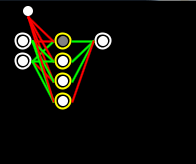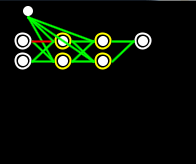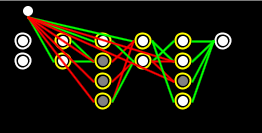A Java implementation of Backpropagation, Feed-Forward, and NEAT networks.
Use the network builder class to generate a Backpropagating network.
(BackPropNetwork) NetworkBuilder
.create(NetworkType.BACKPROP)
.setLabel("XOR GATE")
.setInputLayer(
LayerBuilder
.create()
.addNodes(2, Activations.sigmoid))
.addHiddenLayer(
LayerBuilder
.create()
.addNodes(4, Activations.sigmoid))
.setOutputLayer(
LayerBuilder
.create()
.addNodes(1, Activations.sigmoid)
)
.withBiasNode()
.withVisualizer()
.withSettings(
BackPropSettings
.create()
.setLearningRate(0.04)
.setRandomSeed(3000))
.createAllConnections()
.build(); To train the network execute the following code.
private static final double MIN_ERROR = 0.0001;
private static final int TRAINING_LIMIT = 250000;
int cycle = 0;
while (network.getTotalError() > MIN_ERROR && cycle < TRAINING_LIMIT) {
network.clear();
network.train();
cycle++;
}To get the output execute the following code.
network.clear();
network.setInput(input);
network.calculate();
network.getOutput();Using the network builder class we can also create a NEAT network.
(NeatNetwork) NetworkBuilder
.create(NetworkType.EVOLUTION)
.setLabel("XOR GATE")
.setInputLayer(
LayerBuilder
.create()
.addNodes(2, Activations.sigmoid))
.addHiddenLayer(
LayerBuilder
.create()
.addNodes(0, Activations.sigmoid))
.setOutputLayer(
LayerBuilder
.create()
.addNodes(1, Activations.sigmoid)
)
.withBiasNode()
.withSettings(
NeatSettings
.create()
.setRandomSeed(3000)
.setHiddenNodeCap(4)
.setHiddenLayerCap(1)
.setMaxMutations(5)
.setWeightAdjustment(1)
.setMaxWeight(10.0)
.setMinWeight(-10.0)
.setPopulationSize(500)
.setActivation(Activations.sigmoid))
.build(); First we implement the NeatFitness class to determine the fitness of each network during the evolution process. In this case, it is the XOR function.
public class XORFitness implements NeatFitness {
@Override
public double calculate(Network network) {
double[][] inputs = new double[][] {{1, 1}, {1, 0}, {0, 1}, {0, 0}};
double[][] outputs = new double[][] {{0}, {1}, {1}, {0}};
double score = 0;
for (int i = 0; i < inputs.length; i++) {
double[] input = inputs[i];
double[] output = outputs[i];
network.clear();
network.setInput(input);
network.calculate();
double[] actual = network.getOutput();
double err = Math.abs(output[0] - actual[0]);
score += output[0] == 0 ? 1.0 - err : 1.0 - (err * 2);
}
return score;
}
}Next, we apply the fitness function to the network and we begin the evolution process.
network.setFitness(new XORFitness());
int expectedFitness = 3.5;
int generation = 0;
while (network.getFitness() < expectedFitness) {
network = network.train();
generation++;
}We first clear any existing input and then set ours, and execute the feed-forward process to get the output.
network.clear();
network.setInput(new double[] {1,1});
network.calculate();
network.getOutput();- Java 8+
- Maven 1.3+


